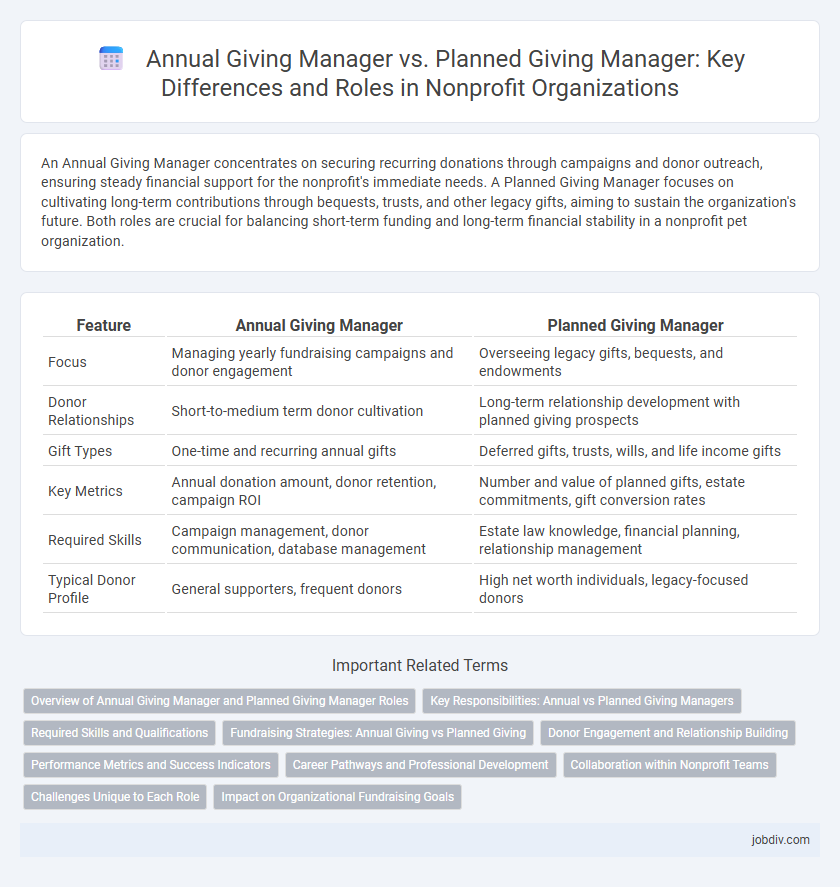An Annual Giving Manager concentrates on securing recurring donations through campaigns and donor outreach, ensuring steady financial support for the nonprofit's immediate needs. A Planned Giving Manager focuses on cultivating long-term contributions through bequests, trusts, and other legacy gifts, aiming to sustain the organization's future. Both roles are crucial for balancing short-term funding and long-term financial stability in a nonprofit pet organization.
Table of Comparison
| Feature | Annual Giving Manager | Planned Giving Manager |
|---|---|---|
| Focus | Managing yearly fundraising campaigns and donor engagement | Overseeing legacy gifts, bequests, and endowments |
| Donor Relationships | Short-to-medium term donor cultivation | Long-term relationship development with planned giving prospects |
| Gift Types | One-time and recurring annual gifts | Deferred gifts, trusts, wills, and life income gifts |
| Key Metrics | Annual donation amount, donor retention, campaign ROI | Number and value of planned gifts, estate commitments, gift conversion rates |
| Required Skills | Campaign management, donor communication, database management | Estate law knowledge, financial planning, relationship management |
| Typical Donor Profile | General supporters, frequent donors | High net worth individuals, legacy-focused donors |
Overview of Annual Giving Manager and Planned Giving Manager Roles
An Annual Giving Manager focuses on coordinating and executing yearly fundraising campaigns, optimizing donor retention, and managing direct mail, email, and event-driven solicitations to sustain steady revenue streams. A Planned Giving Manager specializes in securing long-term legacy gifts through estate planning, bequests, and trusts, cultivating relationships with donors interested in leaving a lasting impact. Both roles are essential for nonprofit financial health, with Annual Giving driving immediate income and Planned Giving ensuring future endowment growth.
Key Responsibilities: Annual vs Planned Giving Managers
Annual Giving Managers focus on developing and executing campaigns to secure recurring donations from individual donors, managing donor databases, and organizing fundraising events to maintain steady cash flow. Planned Giving Managers specialize in building relationships with donors to secure long-term philanthropic gifts through bequests, trusts, and endowments, requiring expertise in legal and financial aspects of legacy gifts. Both roles are crucial for nonprofit sustainability, with Annual Giving driving immediate support and Planned Giving ensuring future financial stability.
Required Skills and Qualifications
Annual Giving Managers require strong skills in donor communication, database management, and campaign coordination, typically holding a degree in nonprofit management, marketing, or communications. Planned Giving Managers need expertise in estate planning, tax law, and financial advising, often possessing certifications such as CFRE or specialized training in legal and financial instruments. Both roles demand excellent relationship-building abilities, attention to detail, and experience with fundraising strategies tailored to their specialized giving programs.
Fundraising Strategies: Annual Giving vs Planned Giving
Annual Giving Managers focus on securing consistent, short-term donations through campaigns, events, and donor engagement to maintain steady cash flow. Planned Giving Managers develop long-term fundraising strategies by encouraging donors to include the nonprofit in wills, trusts, or life insurance policies, ensuring future financial stability. Both roles complement each other by balancing immediate funding needs with sustainable legacy gifts.
Donor Engagement and Relationship Building
Annual Giving Managers focus on cultivating broad donor bases through frequent communication and targeted campaigns, enhancing donor engagement with personalized appeals and timely recognition. Planned Giving Managers build long-term relationships by guiding donors through complex estate and legacy gifts, fostering deep trust and sustained commitment. Both roles prioritize relationship building but differ in engagement strategies, with annual giving emphasizing immediate support and planned giving securing future financial stability.
Performance Metrics and Success Indicators
An Annual Giving Manager is evaluated primarily on metrics such as donor retention rates, average gift size, and total annual donations, reflecting short-term fundraising effectiveness. In contrast, a Planned Giving Manager's success hinges on securing long-term commitments through legacy gifts, measured by the number and value of bequests, charitable remainder trusts, and estate gifts. Both roles require analyzing donor engagement frequency and campaign response rates, but Planned Giving emphasizes the quality and longevity of contributions over immediate revenue.
Career Pathways and Professional Development
Annual Giving Managers develop expertise in donor engagement strategies and short-term fundraising campaigns, providing a foundation for roles in development or communications. Planned Giving Managers specialize in estate planning, legal compliance, and long-term donor relationships, positioning themselves for advanced roles in nonprofit leadership or philanthropic advising. Both career pathways offer opportunities for professional development through certifications like CFRE and continuous education in fundraising ethics, tax laws, and donor stewardship.
Collaboration within Nonprofit Teams
Annual Giving Managers and Planned Giving Managers collaborate closely to maximize fundraising impact by aligning short-term donation goals with long-term legacy commitments. Effective communication between these roles ensures donor data integration and personalized stewardship strategies, enhancing donor retention and lifetime value. Their teamwork supports a holistic approach to development, driving sustainable revenue growth for nonprofit organizations.
Challenges Unique to Each Role
Annual Giving Managers face challenges in maintaining donor engagement through frequent appeals and managing high volumes of small to mid-level gifts, requiring strong marketing skills and rapid donor communication. Planned Giving Managers encounter complexity in educating donors on legacy gifts, handling legal and financial intricacies, and building long-term relationships for deferred gifts, demanding expertise in estate planning and personalized stewardship. Both roles require tailored strategies to navigate donor expectations and fundraising timelines effectively.
Impact on Organizational Fundraising Goals
Annual Giving Managers drive consistent revenue through recurring donor campaigns, enhancing cash flow stability and enabling short-term program funding. Planned Giving Managers secure substantial, long-term financial commitments via bequests and endowments, ensuring future organizational sustainability and growth. Both roles complement fundraising goals by balancing immediate operational needs with legacy building and capital expansion.
Annual Giving Manager vs Planned Giving Manager Infographic

 jobdiv.com
jobdiv.com